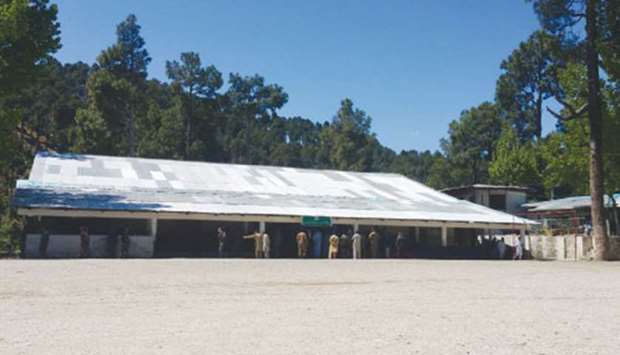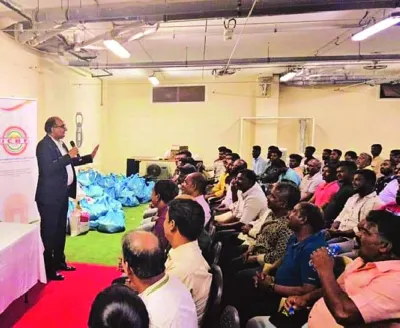Pakistan has escorted a group of foreign journalists and diplomats to the site of an Indian air strike to show that, contrary to Delhi’s claims, no infrastructure was damaged, the military spokesman said.
The visiting group, which Major General Asif Ghafoor said was mostly based in Delhi, was shown observing a crater in Balakot in video published via Twitter late on Wednesday, on the eve of India’s massive election.
The group saw the “ground realities” of the strike site, Ghafoor said in a caption accompanying the tweet.
Indian Prime Minister Narendra Modi has campaigned hard on what he claims is the success of the February 26 strike.
Indian officials have claimed up to 250 militants were killed.
Pakistan has denied from the start that there was any damage or casualties, with Modi’s counterpart Imran Khan framing it as an election ploy.
With the first phase of polls in India’s massive election opening yesterday, Modi has styled himself as India’s chowkidar (“watchman”), and anyone even questioning the action against Pakistan is given short shrift.
However, independent reporting by multiple local and international outlets who have visited the site found no evidence of a major terrorist training camp – or of any infrastructure damage at all.
The expectation among some of the visitors was that it might help to settle a number of mysteries about the attack.
In particular, whether, as India had said, it was a huge success and took out a major militant training camp or whether – as Pakistan says – India’s warplanes missed the madrasa compound completely and hit surrounding hills instead.
There was also the question about whether the madrasa, one of more than 30,000 across Pakistan where children of all ages are taught to memorise and recite the Qur’an, was a cover for the Islamist group Jaish-e-Mohamed (JeM), which was allegedly using the site to train fighters to infiltrate Indian-controlled Kashmir.
JeM claimed responsibility for a suicide car bomb attack in Kashmir that killed 40 Indian paramilitary police on February 14, triggering the Indian attack and the worst hostilities between the two nuclear-armed nations for many years.
An AFP reporter who visited just hours after the February 26 strike was carried out saw damage only to trees and one mud hut.
Local residents have said no one was killed.
The Atlantic Council’s Digital Forensic Research Lab said that open-source satellite imagery indicated “only impacts in the wooded area, with no damage being visible to the surrounding structures”.
The February 26 strike was followed by Pakistani air strikes which hit open space in Indian territory and ignited a dogfight in the skies over the disputed region of Kashmir, the worst confrontation between the nuclear-armed foes in years.
Pakistan said it shot down two Indian war planes, with one falling on the Indian side of the de facto Kashmir border.
It captured the pilot of the other, releasing him days later in a bid to defuse tensions.
India says that just one of its planes was shot down, and claimed that the second plane was a Pakistani F-16 shot down by the Indian air force.
Pakistan has denied that claim also, and Foreign Policy magazine has reported that the US had done a count of all Pakistan’s F-16s, with none missing.
The journalists and diplomats who took part in Wednesday’s visit, most of whom spent well over an hour climbing steep slopes to get to the madrasa in the Jaba village area near the town of Balakot, did not get enough time to make any kind of informed assessment.
They were mostly restricted to looking around the madrasa’s main building.
They were hurried away by the army, which organised the trip, after less than half an hour.
Those arriving by vehicle had even less time.
The interactions with teachers and about 100 children at the madrasa – from the very young to teenagers – were limited.
The visitors were shown a group of children learning passages from the Qur’an.
One teacher said he had worked at the madrasa for six years.
At least three of the diplomats, who were mainly from Western countries and the Middle East and included some military attaches, said it was very difficult to draw any firm conclusions because of the six-week delay in gaining access and the restricted time allowed to look around.
“I don’t think the site was hit, but I still can’t be 100% after today,” said one Western diplomat. “As to whether JeM were here – they may have been but I can’t determine that from this either.”
The diplomats declined to be named given the sensitivity of the subject.
When asked after the visit about the limitations, Major General Ghafoor said that Pakistan had nothing to hide and that if schedules allowed, journalists could in the future come and spend a night or even a month at the site.
He denied that the madrasa had recently been used by JeM.
If there was a relationship, it was a long time ago, he suggested.
Indian Foreign Secretary Vijay Gokhale said on the day of the strike, February 26, that “a very large number of JeM terrorists, trainers, senior commanders, and groups of jihadis who were being trained for Fidayeen action were eliminated” in the attack.
Fidayeen is a term used to describe Islamist militants, or jihadis, on suicide missions.
Other Indian officials have come up with similar claims but despite repeated requests from journalists, the Indian government has not produced evidence that a camp was destroyed or that any militants were killed.
Senior government officials – including Prime Minister Modi – have attacked opposition politicians who ask for evidence as unpatriotic.
Satellite pictures have indicated that the main structures on the hill top appear to be in similar condition after the attack as they were before.
Those visiting the site on Wednesday did not see any signs that there had been significant building work to either clear structures or erect new ones.
And the vegetation did not appear to have suffered the stress that might be expected from a missile attack.
A series of Indian media reports claimed in March that the Indian jets had used smaller precision-guided bombs with warheads that were capable of penetrating a building and then killing its occupants but without blowing up the structure.
Major General Ghafoor told the foreign journalists earlier in the week that he could not understand how the idea of a missile that blows up inside buildings like those at the madrasa without hurting the structure could carry any credibility.
He challenged India to show how that could be done.
The main madrasa building itself does not appear to be reinforced in any major way – it has a metal roof with some modest wooden beams.
Pakistani Prime Minister Imran Khan, meeting foreign correspondents in Islamabad on Tuesday, asked if there had ever been a target.
“We are still in two minds,” he said. “Did they intend to hit a target or was it just symbolic?”
Kashmir has been divided between India and Pakistan since the end of British colonial rule in 1947.
Both claim the Himalayan territory in full and have fought two wars over it.

This picture taken on Wednesday shows a madrasa in Jaba village near Balakot, situated near an impact site, after Indian military aircrafts struck on February 26, according to Pakistani officials.


